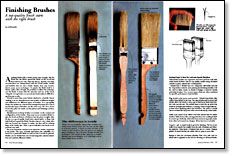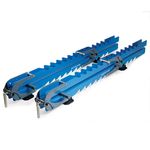Finishing Brushes
A top-quality finish starts with the right brush
Synopsis: Furniture finisher Jeff Jewitt offers advice on selecting and using a brush to ensure a streak- and bubble-free result. He talks about the art of brushmaking and what components are most important to pay attention to. He says animal hair brushes are best for solvent-based finishes, and he details various types. Photographs detailing the anatomy of a brush show how some brushes are better than others. Synthetic bristles are best for water-based finishes, he says, and he discusses brush and bristle variations. Jewitt explains how to buy a brush, shares his favorite types, and details the steps involved in properly cleaning a brush.
Applying finish with a brush seems easy enough. Dip the brush into the finish, spread the finish on the wood and then wait for it to dry. That’s the theory, anyway, but many woodworkers are disappointed with the brush marks, streaks and bubbles that can mar a finish. Maybe, they may wonder, there’s some secret technique. Or maybe the finish itself is to blame. Quite often, though, the problem is neither the technique nor the finish. It starts with the selection and use of the brush. Using the wrong brush or a second-rate brush makes it difficult to get first-rate results.
A brush is more than some bristles attached to a handle. Brushmaking is an art. Manufacturers mix bristles of different lengths and stiffnesses for different types of brushes. In a top-quality brush, the bristles are selected and arranged by hand. For a closer look at the parts of a brush, see the photos and drawings on these two pages.
Manufacturers of cheap brushes economize on the content and configuration of the bristles. They may use an oversized divider to give the brush an illusion of fullness. Bristle tips on a good-quality brush have natural splits, or flags, that help hold and spread the finish. Brushes that are cut to shape after they are formed are cheaper to make, but they will be missing flags at the bristle tips. That’s a good indication the brush won’t perform very well.
The most important, and the most expensive, brush component is the bristle. The type of bristle determines the suitability of a brush for a particular finish as well as how it works in general. Bristles can be divided into two broad categories: natural animalhair and synthetic-filament bristles.
Animal hair is best for solvent-based finishes
Natural-hair brushes are expensive and don’t perform well with water-based finishes. But for top-quality results using oil-based varnish or paint, natural hair is unsurpassed.
Natural hair is divided into two categories: stiff bristle and soft fur. Hog bristle is used in most painting and finishing brushes. Soft fur, such as sable, camel, ox, skunk or badger, is used for varnish and artist’s brushes. Two or more types of hair are often combined for specific performance characteristics.
From Fine Woodworking #116
For the full article, download the PDF below:
Fine Woodworking Recommended Products

Rockler Deluxe Panel Clamp

Foam Brushes

Estwing Dead-Blow Mallet























Log in or create an account to post a comment.
Sign up Log in